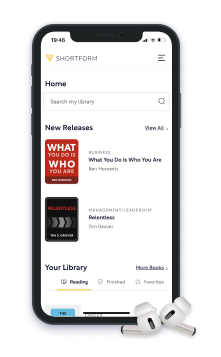

This article gives you a glimpse of what you can learn with Shortform. Shortform has the world’s best guides to 1000+ nonfiction books, plus other resources to help you accelerate your learning.
Want to learn faster and get smarter? Sign up for a free trial here .
What’s the secret to giving a good speech? How should you prepare for a speech?
Public speaking is frightening to many people, but being prepared will help calm your nerves. Once you feel confident enough to get up on stage, you’ll be able to deliver a powerful speech that will inspire others.
Below, we’ll look at how to give a good speech that’s authentic and unforgettable.
Why a Passionate Speech Is Important
Choosing a topic that you’re passionate about is important for several reasons, according to Carmine Gallo’s book Talk Like TED. First, if you deeply care about the subject you’re about to talk about, you’re less likely to feel nervous about your presentation. You’ll be so excited about getting to share your passion with the world that the idea of your speech going wrong won’t even cross your mind.
Second, when you’re passionate about your topic, you’re likely to speak enthusiastically. You’ll therefore be more interesting to watch than a bored and lackluster speaker. People are more likely to actually pay attention to you and what you’re saying, and your message is more likely to sink in.
Finally, studies have shown that feelings are contagious—they spread from person to person. Therefore, if you speak with passion, your audience will feel your excitement, and they’ll listen intently to what you’re saying.
TED Talk Example: Dr. Jill Bolte Taylor
In 2008, Dr. Jill Bolte Taylor gave a TED talk about a severe stroke she’d suffered 12 years earlier. She described in detail how she slowly felt her brain function deteriorating as the stroke progressed. Taylor also discussed the spiritual awakening that her stroke triggered.
The response to Taylor’s TED talk was overwhelmingly positive. It was the first TED talk to go “viral” online, quickly accumulating millions of views. In the aftermath of the talk, Taylor’s book detailing her stroke and recovery process became a bestseller and was translated into 30 languages. TIME magazine named her as one of the top 100 most influential people of 2008.
Gallo argues that the key to Taylor’s talk’s success lay in her true passion for her subject. She was fascinated by and enthusiastic about the topic, not only because it related to a transformative experience in her life, but also because she was a trained neuroanatomist. Even before her stroke, Taylor’s life’s work and passion had been studying the brain and its workings.
This passion shone through as Taylor gave her TED talk. Her enthusiasm and energy were infectious, and the result was a speech that captivated millions of people worldwide.
If you’re an entrepreneur, you must be able to speak passionately about your product, service, or idea for two reasons. First, research has shown that you’re more likely to secure funding from investors if you speak passionately about your business. In one study, investors ranked passion as the third most important criteria when deciding whether or not to offer funds to a business leader.
Second, if you can’t muster passion when discussing your business idea with your employees, they won’t feel passionate about the business either. Consequently, they won’t care about the business enough to work hard on their daily tasks. Your company’s performance will likely suffer as a result.
To ensure that you consistently speak passionately about your business, make sure you genuinely care about the product or service you’re putting out into the world. Lots of people pursue a business idea not because they’re really passionate about it, but because they think it’ll generate a quick profit. Don’t fall into this trap. If you do, you’ll struggle to recruit the people who really matter: committed investors and dedicated employees. Without them, it’s unlikely you’ll get your business off the ground, let alone make a huge profit.
The 4 Steps of Writing a Good Speech
Now let’s look at the ways to give a good speech that your audience will remember. We’ve broken down this process into four steps: writing and rehearsing your speech, practicing relaxation techniques, using confident body language, and closing out strong.
1. Write and Rehearse Your Speech
Writing your speech is the first step. Winging it might make you look disorganized, as you haven’t rehearsed what you’re going to say beforehand. If your thoughts seem scattered, your audience will less likely listen to what you have to say.
Know Your Audience
Before you sit down to write a good speech, Joel Schwartzberg’s book Get to the Point! suggests knowing who your audience will be first. You also need to know what they want from you, so you can tailor your message, language, and tone to them.
For example, if you’re giving a speech to students at an all-boys high school, your delivery and the stories you use to illustrate your point should be relevant to them and should be different from how you’d convey your message to a roomful of female entrepreneurs. With the first group, you might take the tone of “coach” or “mentor,” while the second group would appreciate your talking to them like a peer.
Present Something New
Talk Like TED recommends presenting something new to your audience to capitalize on the human brain’s love of learning new things. According to neuroscientists, when we learn something new, the brain releases dopamine—a hormone that makes us feel good. Because this dopamine rush is so pleasurable, people constantly seek out ways to replicate it: In other words, they look for sources of new knowledge. If you provide this knowledge during your talk, you’re more likely to keep people interested in what you’re saying.
Likewise, because what you’ve said has made your audience feel good, they’re more likely to be receptive to you and your ideas. They’ll link what you’re saying with feeling positive, and they’ll respond with positivity in turn.
Tell a Story
The third principle of preparing a good speech is telling your audience stories. Incorporate at least one of the following three types of stories into your presentations:
Type #1: A story from your own life. For example, in a speech about your career, you could tell a story about the biggest challenge you’ve overcome so far. In a presentation about an amazing sale you recently made, you could tell the story of how you secured the deal.
Type #2: A story about someone else. This “someone else” could be someone you know personally, a famous person, or a historical figure: anyone who’s had an experience that relates to the topic you’re discussing. For example, when giving a presentation to your colleagues about a new management style you’ve read about, you could tell the story of the person who created the management style and how it worked for them.
Type #3: A story about a product or brand. In some situations, this may involve telling a story about a product or brand that you’ve created. For example, if you’re making a speech to launch your new product, you could tell your audience the story of how you came up with the product’s design.
Other scenarios may require you to tell a story about someone else’s product or brand. For instance, if you’re giving a presentation about why your marketing team should adopt a new brand strategy, you could tell them a story about how a competing brand successfully implemented the strategy.
Incorporate a Shocking Moment
The fourth principle of effective public speaking is incorporating a shocking moment into your speech or presentation. A “shocking moment” is an event that your audience doesn’t anticipate, but which deeply surprises, impresses, or moves them.
Including a shocking moment in your presentations will benefit you in three ways. First, the unexpectedness of the moment will grab your audience’s attention. They’ll become totally focused on what you’re saying and doing, and are therefore more likely to absorb your ideas.
Second, shocking moments get people talking. Your audience will rush to tell everyone they know about the surprising thing they just heard or witnessed. In the process, they’ll spread information about your talk and the ideas you communicated.
Finally, shocking moments are memorable: They frequently stick in an audience’s mind after your presentation. The more your audience thinks about the shocking moment, the more they contemplate the idea you were trying to get across—and the more likely they are to act on that idea.
Follow the Rule of Three
To make your talks brief, follow the Rule of Three, which states that you should only communicate a maximum of three ideas in any one presentation. For example, if you’re asked to give a presentation on your sales successes in the last quarter, pick just three transactions to discuss.

Want to fast-track your learning? With Shortform, you’ll gain insights you won't find anywhere else .
Here's what you’ll get when you sign up for Shortform :
- Complicated ideas explained in simple and concise ways
- Smart analysis that connects what you’re reading to other key concepts
- Writing with zero fluff because we know how important your time is






